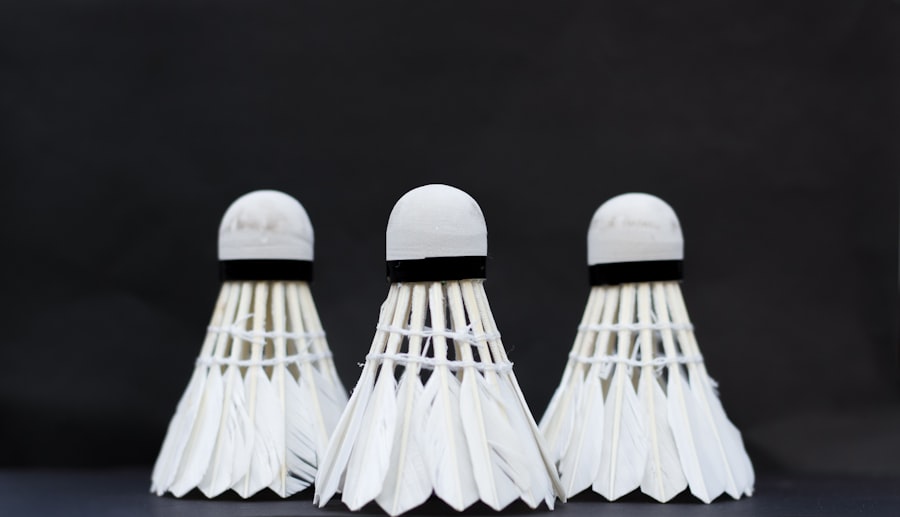Mastering the Art of Badminton: Tips for Success
Description
Badminton is a fast-paced racquet sport that can be played in singles or doubles formats. Originating from the mid-19th century in British India, it has evolved into a globally recognized sport governed by the Badminton World Federation (BWF). The game is played on a rectangular court divided by a net, with players using lightweight racquets to hit a shuttlecock back and forth.
The objective is to score points by landing the shuttlecock in the opponent’s court, while also preventing it from touching the ground on one’s own side. The scoring system typically follows a rally point format, where points can be won regardless of which player served. Understanding the basic rules and scoring system is crucial for anyone looking to engage in badminton.
Each match is played in a best-of-three games format, with each game played to 21 points. Players must win by at least two points, which adds an element of strategy as players must manage their lead carefully. The shuttlecock, often referred to simply as the “birdie,” is unique in its design, featuring a conical shape made of feathers or synthetic materials that allows for a distinctive flight pattern.
This characteristic makes badminton different from other racquet sports, as the shuttlecock’s speed and trajectory can change dramatically based on how it is struck.
Key Takeaways
- Badminton is a fast-paced racket sport played with a shuttlecock, and requires agility, speed, and precision.
- Developing the right technique is crucial for mastering badminton, including proper grip, stance, and swing.
- Improving footwork and speed is essential for covering the court effectively and reacting quickly to opponents’ shots.
- Mastering different types of shots, such as clears, smashes, and drops, is important for keeping opponents off balance.
- Enhancing strategy and game sense involves understanding opponents’ weaknesses and adapting tactics during a match.
Developing the Right Technique
Mastering badminton requires a solid foundation in technique, which encompasses grip, stance, and swing mechanics. The grip is one of the most fundamental aspects of playing badminton effectively. There are primarily two types of grips: the forehand grip and the backhand grip.
The forehand grip is used for most shots and involves holding the racquet as if shaking hands with it, allowing for maximum control and power.
Practicing these grips consistently will help players develop a more versatile playing style.
In addition to grip, stance and swing mechanics play a pivotal role in shot execution. A proper stance allows players to maintain balance and react quickly to their opponent’s shots. Players should adopt a ready position with feet shoulder-width apart, knees slightly bent, and weight distributed evenly on both feet.
This position enables quick lateral movements and swift transitions between offensive and defensive plays. The swing mechanics involve not only the arm but also the entire body; generating power through the legs and core can significantly enhance shot effectiveness.
Improving Footwork and Speed

Footwork is often regarded as one of the most critical components of badminton performance. Effective footwork allows players to position themselves optimally for each shot, ensuring they can respond quickly to their opponent’s plays. A common practice among advanced players is to incorporate agility drills into their training regimen. These drills may include ladder exercises, cone sprints, and lateral shuffles that enhance quickness and coordination.
By improving footwork, players can cover the court more efficiently, reducing the time it takes to reach the shuttlecock. Speed is another essential factor in badminton, as rallies can unfold rapidly. Players must develop not only their sprinting ability but also their ability to change direction swiftly.
Plyometric exercises, such as box jumps and burpees, can help build explosive strength that translates well into on-court speed. Additionally, practicing specific footwork patterns—such as the split step, which involves a quick hop just before an opponent strikes the shuttlecock—can prepare players to react more effectively during matches. By combining agility training with speed drills, players can enhance their overall performance on the court.
Mastering Different Types of Shots
| Shot Type | Definition | Importance |
|---|---|---|
| Forehand | A shot played with the racket in a vertical position and the palm of the hand facing the direction of the shot. | Allows for powerful and accurate shots. |
| Backhand | A shot played with the back of the hand facing the direction of the shot. | Essential for covering the other side of the court and maintaining balance. |
| Volley | A shot played before the ball bounces on the court. | Allows for quick and aggressive play at the net. |
| Overhead Smash | A powerful shot played above the head when the ball is high in the air. | Effective for finishing points and putting pressure on opponents. |
A well-rounded badminton player must be proficient in various types of shots, each serving a unique purpose during gameplay. The fundamental shots include clears, drops, smashes, and drives. The clear shot is typically used to push the shuttlecock high and deep into the opponent’s court, allowing players time to reposition themselves.
It can be executed from both forehand and backhand positions and is essential for defensive play. The drop shot, on the other hand, is a delicate maneuver designed to land just over the net, catching opponents off guard. It requires precise control and timing to execute effectively.
Smashes are powerful downward strikes aimed at overwhelming opponents with speed and force; mastering this shot can significantly increase a player’s offensive capabilities. Finally, drives are fast horizontal shots that keep opponents on their toes and can be used strategically to maintain pressure during rallies. Practicing these shots in isolation and during match simulations will help players develop a comprehensive skill set.
Enhancing Strategy and Game Sense
Beyond technical skills, developing strategic thinking is vital for success in badminton. Players must learn to read their opponents’ movements and anticipate their next shots. This involves observing patterns in an opponent’s play style—such as their preferred shot types or weaknesses—and adapting one’s own strategy accordingly.
For instance, if an opponent consistently struggles with high clears, a player might exploit this weakness by frequently using that shot to gain an advantage. Moreover, understanding court positioning is crucial for effective gameplay. Players should aim to control the center of the court whenever possible, as this allows for quicker access to all areas of play.
Additionally, employing deceptive shots can create openings by misleading opponents about one’s intentions. For example, a player might feign a smash only to execute a drop shot instead, forcing their opponent to misjudge their position. Regularly analyzing match footage or engaging in discussions with coaches can further enhance strategic awareness.
Strengthening Physical Fitness and Endurance

Physical fitness plays an integral role in badminton performance, as matches can be physically demanding and require sustained energy levels. A well-rounded fitness program should include cardiovascular training, strength training, flexibility exercises, and endurance workouts. Aerobic activities such as running or cycling can improve overall stamina, allowing players to maintain high levels of performance throughout long matches.
Strength training should focus on building muscle groups that are particularly important for badminton players—such as legs, core, and shoulders—to enhance power during shots and improve overall stability on the court. Resistance exercises like squats, lunges, and shoulder presses can be beneficial in this regard. Flexibility is equally important; incorporating stretching routines or yoga can help prevent injuries while improving range of motion.
By committing to a comprehensive fitness regimen that addresses these various components, players can significantly enhance their performance levels.
Mental Preparation and Focus
Mental preparation is often overlooked but is crucial for achieving peak performance in badminton. The psychological aspect of sports can greatly influence a player’s ability to perform under pressure. Techniques such as visualization can be particularly effective; players may visualize themselves executing perfect shots or winning critical points during matches.
This mental rehearsal helps build confidence and reduces anxiety when facing real competition. Additionally, developing focus during matches is essential for maintaining composure amidst distractions. Mindfulness practices—such as meditation or breathing exercises—can help players cultivate concentration skills that are beneficial during high-stakes situations.
Establishing pre-match routines can also aid in mental preparation; these routines might include specific warm-up exercises or positive affirmations that set a confident tone before stepping onto the court.
Seeking Professional Coaching and Training
While self-directed practice is valuable, seeking professional coaching can accelerate skill development significantly. Coaches provide personalized feedback that helps identify areas for improvement that players may overlook themselves. They can also introduce advanced techniques and strategies tailored to individual playing styles and goals.
Many clubs offer structured training programs led by experienced coaches who have competed at high levels themselves. In addition to one-on-one coaching sessions, participating in group training can foster camaraderie among players while providing opportunities for competitive practice against peers of varying skill levels. Engaging in tournaments or local leagues under professional guidance allows players to gain experience in real match situations while receiving constructive feedback afterward.
By investing time in professional coaching and structured training environments, players can refine their skills more effectively than through solo practice alone. In summary, badminton is a multifaceted sport that requires dedication across various domains—from mastering techniques and improving physical fitness to enhancing mental resilience and strategic thinking. By understanding these elements deeply and committing to continuous improvement through practice and professional guidance, players can elevate their game significantly while enjoying all that badminton has to offer.
If you’re a fan of Badminton, you may also be interested in checking out the latest version of WhatsApp Business. This messaging app can help you stay connected with your teammates and coordinate game schedules more efficiently. You can download the WhatsApp Business APK v2.23.26.18 from the link provided.
FAQs
What is badminton?
Badminton is a racquet sport played by either two opposing players (singles) or two opposing pairs (doubles), who take positions on opposite halves of a rectangular court divided by a net.
What equipment is used in badminton?
The primary equipment used in badminton includes a shuttlecock (also known as a birdie), badminton racquets, and a net. Players also typically wear appropriate athletic clothing and non-marking shoes.
What are the basic rules of badminton?
The basic rules of badminton include serving diagonally, scoring points by landing the shuttlecock within the opponent’s court, and winning a match by winning two out of three games.
What are the health benefits of playing badminton?
Playing badminton can provide numerous health benefits, including improved cardiovascular fitness, agility, coordination, and flexibility. It also helps in burning calories and improving overall physical fitness.
What are the different types of badminton shots?
Some of the different types of badminton shots include the clear, drop shot, smash, drive, and the backhand shot. Each shot has its own specific technique and purpose during a game.
What are the major badminton tournaments and events?
Some of the major badminton tournaments and events include the All England Open Badminton Championships, BWF World Championships, Thomas Cup (men’s team event), Uber Cup (women’s team event), and the Olympic Games.





